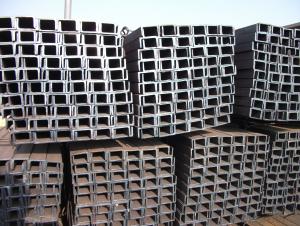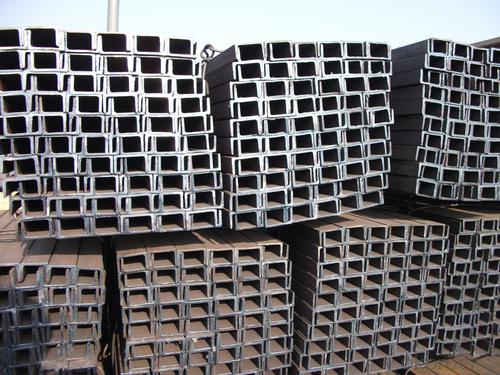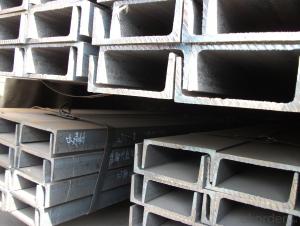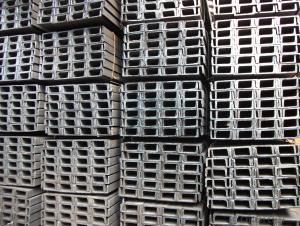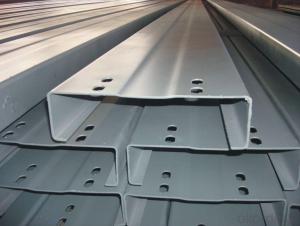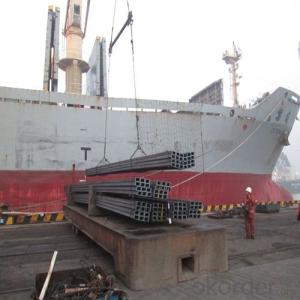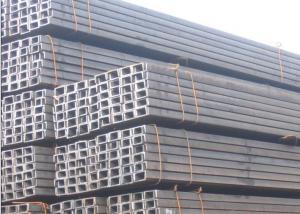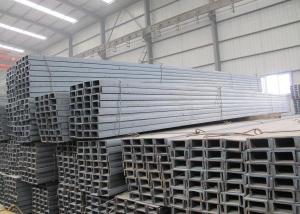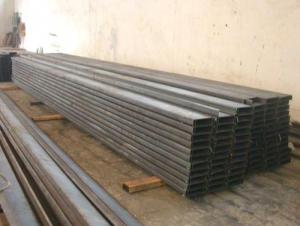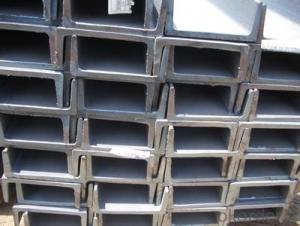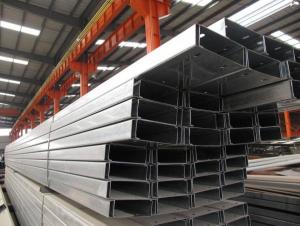U Channels JIS Standard Hot Rolled Steel U Channels SS400
- Loading Port:
- Tianjin
- Payment Terms:
- TT or LC
- Min Order Qty:
- 25 m.t.
- Supply Capability:
- 200000 m.t./month
OKorder Service Pledge
OKorder Financial Service
You Might Also Like
Product Description of U Channels JIS Standard Hot Rolled Steel U Channels SS400
JIS Standard Hot Rolled Steel U Channels SS400 Details:
Minimum Order Quantity: 25 Tons Unit: m.t. Loading Port: Xingang Port
Supply Ability: 1000 Tons Per Day Payment Terms: TT or L/C
Specifications of U Channels JIS Standard Hot Rolled Steel U Channels SS400
Standard Applied: GB Standard, EN Standard(UPN), JIS Standard
Sizes: 50mm to 300mm
Material Grade: Q235B, Q345B, S235JR, SS400, ASTM A36
As shown in the figure:
Usage/Application of U Channels JIS Standard Hot Rolled Steel U Channels SS400
The steel u channel can be applied to construction of warehouses, workshops, sport stadiums and car parks etc. In details, the steel u channel belongs to carbon structural steel which is applied to in the field of construction and machinery. The steel u channel is usually used for arch-itechtural structure, and they could be welded in order to support or hang a vari-ety of facilities. They are also usually used in combination with I beam. Generally,the steel u channel must possess perfect welding property, riveting property and mechanical property and so on.
Package & Delivery of U Channels JIS Standard Hot Rolled Steel U Channels SS400
The steel u channel will be packed in bundle with steel wire at each end of every bundle and color marking in order to help the customer to recognize his goods more easily at sight.
And steel u channel could be loaded into 20ft or 40ft container, or by bulk cargo. If the weight of each bundle reaches less than 3.5 mt, the loading by break bulk cargo should be choosed. When the weight of each bundle reaches less than 3mt, the loading by container should be choosed.
As for the transportaion from mill to loading port, the truck will be usually used. And the maximum quantity for each truck is 40mt.
All in all, we could do in accordance with customer's request
Images of U Channels JIS Standard Hot Rolled Steel U Channels SS400


FAQ
Q1: Why buy Materials & Equipment from OKorder.com?
A1: All products offered byOKorder.com are carefully selected from China's most reliable manufacturing enterprises. Through its ISO certifications, OKorder.com adheres to the highest standards and a commitment to supply chain safety and customer satisfaction.
Q2: How do we guarantee the quality of our products?
A2: We have established an advanced quality management system which conducts strict quality tests at every step, from raw materials to the final product. At the same time, we provide extensive follow-up service assurances as required.
Q3: How soon can we receive the product after purchase?
A3: Within three days of placing an order, we will begin production. The specific shipping date is dependent upon international and government factors, but is typically 7 to 10 workdays.
- Q: Are steel channels suitable for the agricultural industry?
- Yes, steel channels are suitable for the agricultural industry. Steel channels are versatile and durable, making them an ideal choice for various agricultural applications. They can be used to construct structures like barns, sheds, and fencing, providing a strong and long-lasting framework. Steel channels are resistant to corrosion, which is crucial for withstanding the harsh outdoor conditions in the agricultural sector. Additionally, they can support heavy loads and provide stability, making them suitable for equipment such as grain bins or livestock handling systems. Moreover, steel channels can be easily customized and fabricated to meet specific requirements, allowing for flexibility in design and construction. Overall, steel channels offer the strength, durability, and versatility needed in the agricultural industry.
- Q: How do steel channels contribute to natural ventilation?
- Steel channels can contribute to natural ventilation by providing a pathway for the flow of air. When strategically placed within a building or structure, steel channels can help facilitate the movement of fresh air from outside, allowing for proper air circulation and ventilation.
- Q: How do steel channels contribute to fire resistance in buildings?
- Steel channels contribute to fire resistance in buildings in several ways. Firstly, steel channels are often used as structural elements in the construction of buildings. They are commonly used as beams, columns, or joists, providing support and stability to the overall structure. In the event of a fire, these steel channels play a crucial role in maintaining the integrity of the building. Steel has a high melting point and retains its strength at high temperatures, which helps prevent the collapse of the building during a fire. This structural stability allows occupants to safely evacuate and provides firefighters with a safer environment to combat the fire. Secondly, steel channels can be used as fire barriers or fireproofing materials. They can be installed to encase or protect vulnerable areas such as electrical conduits, pipes, or ventilation systems, which are prone to heat transfer and can contribute to the spread of fire. By enclosing these elements with steel channels, the risk of fire propagation is minimized. Steel channels can also be used to create fire-resistant compartments or fire-rated walls, limiting the spread of fire to specific areas and allowing occupants to evacuate safely. Moreover, steel channels can be combined with other fire-resistant materials to enhance their effectiveness. For instance, they can be filled with fire-resistant insulation materials, such as mineral wool or vermiculite, to provide additional thermal protection. This insulation helps to reduce heat transfer and delays the temperature rise on the unexposed side of the steel channel, further increasing the fire resistance of the building. In conclusion, steel channels play a vital role in ensuring fire resistance in buildings. Their structural integrity and ability to withstand high temperatures help prevent building collapse during fires, providing occupants with valuable time to evacuate. Additionally, steel channels can be used as fire barriers, encasing vulnerable elements and limiting the spread of fire. By combining steel channels with fire-resistant insulation, their effectiveness in fire resistance is further enhanced, making them an essential component in building design and construction.
- Q: Are steel channels suitable for seismic zones?
- Steel channels, also known as C-channels or U-channels, are well-suited for seismic zones. Their structural strength and flexibility make them commonly used in seismic design and construction. Steel's high strength-to-weight ratio makes it ideal for withstanding seismic forces. Furthermore, steel channels can be engineered to have the necessary stiffness and ductility to absorb and dissipate energy during an earthquake, reducing the impact of seismic shaking on the structure and making it more resilient and less prone to damage. Additionally, steel channels offer excellent fire resistance, an important consideration in seismic zones. Overall, due to their durability, flexibility, and ability to withstand seismic forces, steel channels are a popular choice for seismic design and construction.
- Q: What are the different types of steel channel connections for column framing?
- There are several types of steel channel connections used for column framing, including welded connections, bolted connections, and pinned connections. Welded connections involve welding the steel channels together to create a strong and rigid joint. Bolted connections use bolts and nuts to secure the channels together, allowing for easier assembly and disassembly. Pinned connections utilize pins or dowels to connect the channels, providing flexibility and allowing for relative movement between the connected members.
- Q: What is the maximum span for steel channels?
- The maximum span of steel channels relies on various factors, including the channel's size, shape, load, and desired deflection criteria. Steel channels are commonly utilized as structural elements in construction projects, and their maximum span is typically determined through engineering calculations and design codes. Generally, larger and stiffer steel channels will have a greater maximum span compared to smaller and more flexible ones. The load-bearing capacity of the channel, influenced by its dimensions and material properties, is a crucial factor in establishing the maximum span. Additionally, the type of load (static or dynamic) and the required deflection criteria will also impact the maximum span. To determine the maximum span for a specific steel channel, it is necessary to refer to relevant design codes such as the AISC Manual or Eurocode standards. These codes provide guidelines and formulas that consider the aforementioned factors to ensure structural safety and integrity. Ultimately, a qualified structural engineer or designer should determine the maximum span for steel channels. They will assess and analyze the specific application and its requirements to ensure optimal and safe performance of the channel within its intended use.
- Q: Can steel channels be used for creating storage racks or shelving units?
- Yes, steel channels can certainly be used for creating storage racks or shelving units. Steel channels are known for their strength and durability, making them ideal for supporting heavy loads. They can be easily fabricated and assembled to create sturdy and long-lasting storage solutions. The versatility of steel channels allows for customization and adaptation to specific storage requirements, such as adjustable shelving heights or different rack configurations. Moreover, steel channels can withstand challenging environments, including warehouses, garages, or industrial settings, ensuring the stability and safety of the storage racks or shelving units.
- Q: For example, channel 8 is bent into a circle with an inner diameter of 1030 and an opening outwards. How do you calculate the lofting length?
- Bend 90 degrees, the diameter of 300MM, is this material: a straight line length is pi (D-T) (d--- pipe diameter, t--- thickness).
- Q: Can steel channels be used for balcony construction?
- Indeed, the utilization of steel channels is viable for the construction of balconies. These versatile structural elements contribute strength and stability to a range of construction endeavors, including the creation of balconies. Frequently employed as support beams or joists in balcony frameworks, steel channels guarantee the steadiness and load-bearing capability of the balcony. Thanks to their remarkable strength-to-weight ratio, steel channels are capable of withstanding substantial loads while ensuring the structural soundness of the balcony. Moreover, the fabrication and installation of steel channels are effortless, rendering them a favored option for balcony construction.
- Q: Are steel channels suitable for architectural applications?
- Yes, steel channels are indeed suitable for architectural applications. Steel channels are versatile and durable, making them an excellent choice for various architectural projects. They can be used for structural purposes, such as supporting large loads or creating frameworks for buildings. Steel channels also offer the advantage of being highly resistant to corrosion and weathering, making them suitable for both indoor and outdoor architectural applications. They can withstand extreme environmental conditions, ensuring the longevity of the structures they are used in. Moreover, steel channels provide design flexibility, as they can be easily fabricated and shaped to meet specific architectural requirements. They can be cut, welded, and formed into various shapes, allowing architects to create unique and aesthetically pleasing structures. Steel channels are commonly used in architectural applications such as curtain wall systems, façades, roof supports, and staircases. They provide strength and stability while also adding a modern and industrial aesthetic to the design. In summary, steel channels are highly suitable for architectural applications due to their strength, durability, resistance to corrosion, and design flexibility. They offer architects and designers the opportunity to create innovative and long-lasting structures.
Send your message to us
U Channels JIS Standard Hot Rolled Steel U Channels SS400
- Loading Port:
- Tianjin
- Payment Terms:
- TT or LC
- Min Order Qty:
- 25 m.t.
- Supply Capability:
- 200000 m.t./month
OKorder Service Pledge
OKorder Financial Service
Similar products
Hot products
Hot Searches
Related keywords
